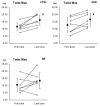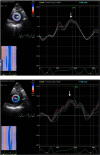Left ventricular twist is load-dependent as shown in a large animal model with controlled cardiac load
- PMID: 22731666
- PMCID: PMC3488500
- DOI: 10.1186/1476-7120-10-26
Left ventricular twist is load-dependent as shown in a large animal model with controlled cardiac load
Abstract
Background: Left ventricular rotation and twist can be assessed noninvasively by speckle tracking echocardiography. We sought to characterize the effects of acute load change and change in inotropic state on rotation parameters as a measure of left ventricular (LV) contractility.
Methods: Seven anesthetised juvenile pigs were studied, using direct measurement of left ventricular pressure and volume and simultaneous transthoracic echocardiography. Transient inflation of an inferior vena cava balloon (IVCB) catheter produced controlled load reduction. First and last beats in the sequence of eight were analysed with speckle tracking (STE) during the load alteration and analysed for change in rotation/twist during controlled load alteration at same contractile status. Two pharmacological inotropic interventions were also included to examine the same hypothesis in additionally conditions of increased and decreased myocardial contractility in each animal. Paired comparisons were made for different load states using the Wilcoxon's Signed Rank test.
Results: The inferior vena cava balloon occlusion (IVCBO) load change compared for first to last beat resulted in LV twist increase (11.67° ±2.65° vs. 16.17° ±3.56° respectively, p < 0.004) during the load alteration and under adrenaline stimulation LV twist increase 12.56° ±5.1° vs. 16.57° ±4.6° (p < 0.013), and though increased, didn't reach significance in negative inotropic condition. Untwisting rate increased significantly at baseline from -41.7°/s ±41.6°/s vs.-122.6°/s ±55.8°/s (P < 0.039) and under adrenaline stimulation untwisting rate increased (-55.3°/s ±3.8°/s vs.-111.4°/s ±24.0°/s (p < 0.05), but did not systematically changed in negative inotropic condition.
Conclusions: Peak systolic LV twist and peak early diastolic untwisting rate are load dependent. Differences in LV load should be included in the interpretation when serial measures of twist are compared.
Figures



Similar articles
-
Left ventricular strain and peak systolic velocity: responses to controlled changes in load and contractility, explored in a porcine model.Cardiovasc Ultrasound. 2012 May 28;10:22. doi: 10.1186/1476-7120-10-22. Cardiovasc Ultrasound. 2012. PMID: 22640913 Free PMC article.
-
Effects of load manipulations, heart rate, and contractility on left ventricular apical rotation. An experimental study in anesthetized dogs.Circulation. 1995 Jul 1;92(1):130-41. doi: 10.1161/01.cir.92.1.130. Circulation. 1995. PMID: 7788907
-
Alterations in left ventricular twist mechanics with inotropic stimulation and volume loading in human subjects.Circulation. 1994 Jan;89(1):142-50. doi: 10.1161/01.cir.89.1.142. Circulation. 1994. PMID: 8281641
-
The relationship between left ventricular late-systolic rotation and twist, and classic parameters of ventricular function and geometry.Kardiol Pol. 2008 Jul;66(7):740-7; discussion 748-9. Kardiol Pol. 2008. PMID: 18690565
-
Prevalence of left ventricular 'rigid body rotation', the near absence of left ventricular twist (insights from the MAGYAR studies).Rev Cardiovasc Med. 2022 Jan 8;23(1):5. doi: 10.31083/j.rcm2301005. Rev Cardiovasc Med. 2022. PMID: 35092197 Review.
Cited by
-
Comparison of left ventricular rotational mechanics between term and extremely premature infants over the first week of age.Open Heart. 2021 Jan;8(1):e001458. doi: 10.1136/openhrt-2020-001458. Open Heart. 2021. PMID: 33504632 Free PMC article.
-
New concept of myocardial longitudinal strain reserve assessed by a dipyridamole infusion using 2D-strain echocardiography: the impact of diabetes and age, and the prognostic value.Cardiovasc Diabetol. 2013 Jun 7;12:84. doi: 10.1186/1475-2840-12-84. Cardiovasc Diabetol. 2013. PMID: 23759020 Free PMC article.
References
-
- Sengupta PP, Krishnamoorthy VK, Korinek J, Narula J, Vannan MA, Lester SJ, Tajik JA, Seward JB, Khandheria BK, Belohlavek M. Left ventricular form and function revisited: applied translational science to cardiovascular ultrasound imaging. J Am Soc Echocardiogr. 2007;20(5):539–551. doi: 10.1016/j.echo.2006.10.013. - DOI - PMC - PubMed
-
- Burns AT, La Gerche A, Prior DL, MacIsaac AI. Left ventricular untwisting is an important determinant of early diastolic function. J Am Coll Cardiol Img. 2009;2(6):709–716. - PubMed
-
- Sandstede JJ, Johnson T, Harre K, Beer M, Hofmann S, Pabst T, Kenn W, Voelker W, Neubauer S, Hahn D. Cardiac systolic rotation and contraction before and after valve replacement for aortic stenosis: a myocardial tagging study using MR imaging. AJR Am J Roentgenol. 2002;178(4):953–958. - PubMed
Publication types
MeSH terms
LinkOut - more resources
Full Text Sources
Research Materials

